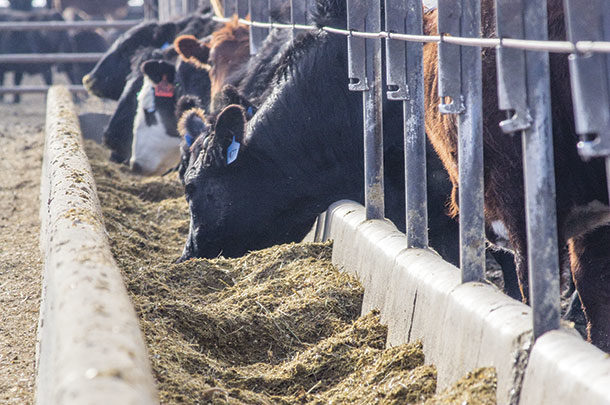Once the corn plant reaches the desired moisture content (traditionally 31 to 34 percent whole-plant dry matter), silage harvesters want to push forward with harvest as quickly as possible – and with good reason, since the window from “too wet” to “too dry” closes in as little as two to three weeks.
However, for some producers, it may be worthwhile to investigate the optimal corn silage harvest time more closely.
Optimal harvest
Physiologic changes in the plant are important to begin the discussion. As the corn plant matures toward black layer formation (approximately 40 percent whole-plant dry matter), the plant is depositing starch in the corn kernel at a rapid rate such that the corn yield is not yet maximized until black layer has occurred.
Once black layer has formed, the forage component dries down and, as a result, the percentage of corn in the plant continues to increase. This is impactful because it means a delayed corn silage harvest will increase the percentage of corn (and therefore starch) in the silage.
Dry matter (DM) yield is also increasing until black layer formation. In recent research conducted at the University of Nebraska, a two-week delay in silage harvest resulted in an 18 percent increase in DM yield per acre.
There are, however, some diminishing returns with delayed harvest because the forage component of silage is also changing. As the plant dries down (dies), cell sugars are metabolized so the concentrate of fiber increases in the forage component of the plant.
Digestibility of the forage component declines rapidly following black layer formation and is actually maximized one to three weeks before the black layer forms.
So how do we balance the increasing DM yield, increasing starch content and decreasing digestibility of the forage component as we move from traditional corn silage harvest to black layer formation? This can be accomplished by measuring the yield of digestible DM per acre.
Instead of measuring the DM yield per acre, we account for how much of that yield will be digested by the animal. The maximum tonnage of digestible DM per acre corresponds with black layer formation.
Effects on animal performance
But what about animal performance? Researchers at the University of Nebraska recently evaluated the impacts of delayed corn silage harvest on animal performance in beef growing and finishing diets. Silages were harvested at 37 and 43 percent DM without kernel processing and were stored in agricultural bags.
Growing diets consisted of 88 percent silage (DM basis) with supplemental protein fed to 600-pound steers for 84 days.
All steers consumed approximately 18 pounds of DM, but the steers fed the 37 percent DM silage gained approximately 0.25 pound more per day, making them 8.5 percent more efficient in converting feed into gain.
Finishing diets contained 15 percent and 45 percent silage, with the remainder of the diets consisting of corn and supplement. The average beginning weights of steers was 940 pounds. The performance of finishing cattle fed corn silage that was 37 percent or 43 percent DM was similar.
The animal response to delayed corn silage harvest was clearly different in growing and finishing diets. This begs the question of why, and what does it mean for producers who rely on silage as a feed ingredient? These results also question why the silage harvested at black layer formation (43 percent DM) resulted in poorer feed efficiency in growing steers, even though digestible yield per acre is greatest at this time.
It has long been understood high-starch diets negatively impact fiber digestion in ruminants. It is likely the increased starch content of the silage harvested at 43 percent DM negatively impacted the digestibility of the forage component of the silage in the rumen.
Because silage made up 88 percent of the diet DM in the growing diets, the reduction in forage digestibility negatively impacted animal performance. This is compounded by the fact the fiber portion of the silage is decreasing as black layer stage approaches, independent of the impacts of starch.
In finishing diets, corn makes up a significant proportion of the diet, so fiber digestion is already inhibited. Since silage contributed a smaller proportion of the diet, the importance of fiber digestion is lessened.
What it means
So what does this mean for producers? Optimal silage harvest likely depends on what the silage will be used for. For producers who rely on digestibility of the fiber as a part of their production system, such as beef growing yards, cow-calf producers and dairymen, an earlier (more traditional) silage harvest may be more appropriate, although it would be good to compare 33 percent DM silage to 37 percent DM silage to confirm this conclusion.
For beef feedlot producers, a delayed harvest (closer to black layer formation) may be beneficial to maximize DM yield per acre and starch content of the silage. A delayed harvest does come with some considerations. The window of harvest is smaller for dryer silages. Storage method is also an important consideration.
The silages used in these studies were stored in agricultural bags, but recommendations for silages stored in bunkers include greater moisture content to aid in packing. Harvesting additional tons of silage per acre is of little value if those pounds of silage are lost as spoilage.
Nevertheless, delaying silage harvest by two weeks does represent an opportunity for some producers interested in maximizing yield potential from their fields. ![]()
PHOTO: Cattle at the feed bunk. Photo by Lynn Jaynes.

-
Jim MacDonald
- Associate Professor of Animal Science
- University of Nebraska
- Email Jim MacDonald












